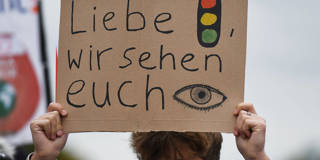When Chancellor Olaf Scholz’s three-party government took office at the end of 2021, it promised to “dare more progress,” signaling a break from the complacency that characterized the last years of Angela Merkel’s chancellorship. But now, 16 months later, surviving the next election has become the more pressing goal.
BERLIN – The policy bottlenecks that many people thought would impede Germany’s Ampelkoalition (“traffic-light coalition”) have materialized, well into its second year in power. The country’s first three-party government since the 1950s, comprising the Social Democrats (SPD), the Greens, and the Liberal Democrats (FDP), took office with an ambitious agenda and high hopes for far-reaching reform. The almost 200-page coalition agreement promised to “Dare More Progress,” signaling a break from the complacency that characterized the last years of Angela Merkel’s chancellorship.
Presenting a raft of policy proposals in an orderly, rational fashion, the coalition agreement gave the impression of a government willing and able to implement reforms. The results so far suggest otherwise. Some, like the electoral reform bill, have been poorly designed, while others, including a recent meeting convened to address the country’s ailing education system, ended in failure.
Policymakers have reneged on promises. Whereas the coalition agreement placed public transportation, especially improvements to the country’s aging railways, at the top of the agenda, Transport Minister Volker Wissing has successfully advocated for building more highways. He also opposed a previously agreed European Union ban on internal combustion engines, forcing member states to settle on a much-criticized last-minute compromise.

BERLIN – The policy bottlenecks that many people thought would impede Germany’s Ampelkoalition (“traffic-light coalition”) have materialized, well into its second year in power. The country’s first three-party government since the 1950s, comprising the Social Democrats (SPD), the Greens, and the Liberal Democrats (FDP), took office with an ambitious agenda and high hopes for far-reaching reform. The almost 200-page coalition agreement promised to “Dare More Progress,” signaling a break from the complacency that characterized the last years of Angela Merkel’s chancellorship.
Presenting a raft of policy proposals in an orderly, rational fashion, the coalition agreement gave the impression of a government willing and able to implement reforms. The results so far suggest otherwise. Some, like the electoral reform bill, have been poorly designed, while others, including a recent meeting convened to address the country’s ailing education system, ended in failure.
Policymakers have reneged on promises. Whereas the coalition agreement placed public transportation, especially improvements to the country’s aging railways, at the top of the agenda, Transport Minister Volker Wissing has successfully advocated for building more highways. He also opposed a previously agreed European Union ban on internal combustion engines, forcing member states to settle on a much-criticized last-minute compromise.